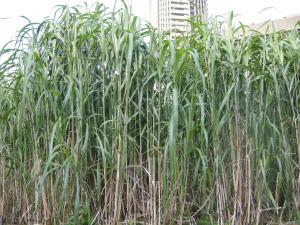
Phragmites australis (24/07/2001, London)
Position: Full sun
Soil: Moist, wet soil
Flowering period: Summer
Eventual Height: 4m
Eventual Spread: 4m
Hardiness: USDA Zone 4a-10b
Family: Poaceae
Phragmites australis is a perennial grass with a tufted habit. Its erect culms bear overlapping sheaths of linear, green or gloucas leaves which become light brown in autumn. In late summer its inflorescence takes the form of terminal dark purple flowering panicles, densely composed from spikelets. It spreads by underground runners which put down roots and where conditions are suitable it may spread up to 5m per year.
P. australis, known as the Common Reed, is a cosmopolitan species ranging across the globe although there is discussion on the topic of separating it into distinct species based on genetic evidence. The plant is currently widely used in the remediation of sewage water and various types of grey water through the use of constructed wetlands. This plant will grow in freely drained soil to water to a depth of 1m.
Phragmites is derived from the Greek phragma, meaning a ‘fence’ or ‘screen’, with australis being a Latinised word meaning ‘of or from Australia’.
The landscape architect may find this plant useful for both terrestrial and water planting, and especially when used in the remediation of spoiled water in the form of formal or informal water treatment beds. Care should be taken when locating this plant as it can be considered as invasive when planted near damp grassland when not grazed by cattle. This plant associates well with river edges, wildflower meadows and wildlife landscapes.
This plant will tolerate almost any soil conditions; it will be happy at neutral, alkaline or acid pH levels, in loam, clay, chalk or sand based soils, in a west or south facing, sheltered or exposed aspect.
Ecologically this plant will attract various species of birds that will use it as cover from predators.
Maintenance: This plant requires little to no maintenance. It may be cut back to ground level in late autumn or winter.

